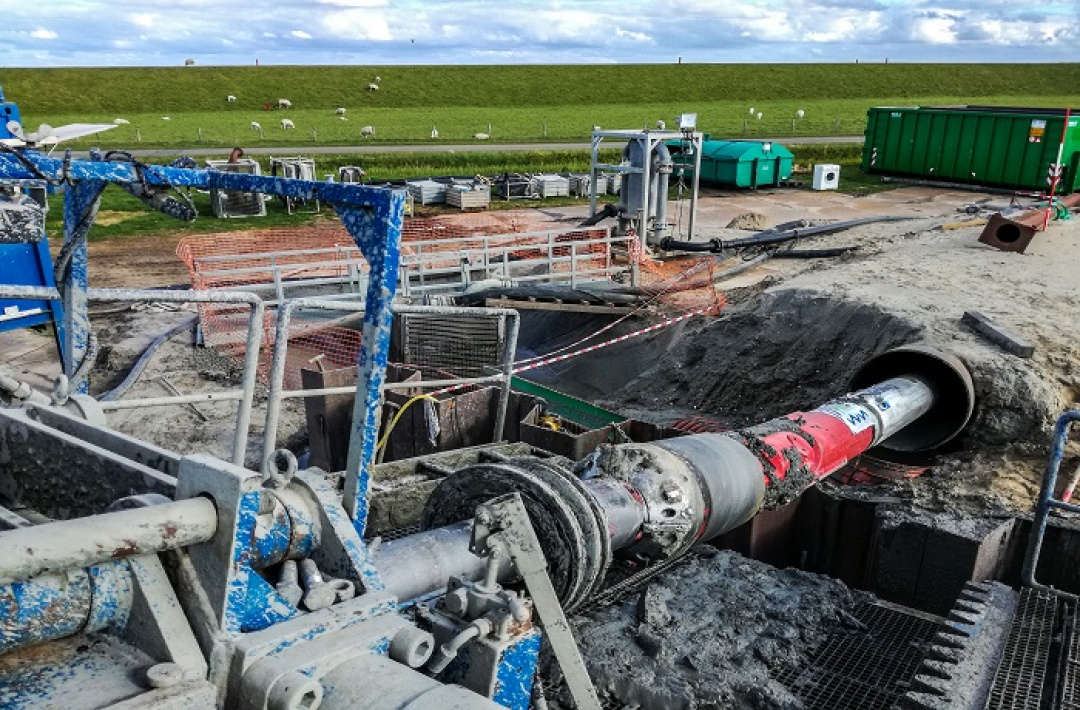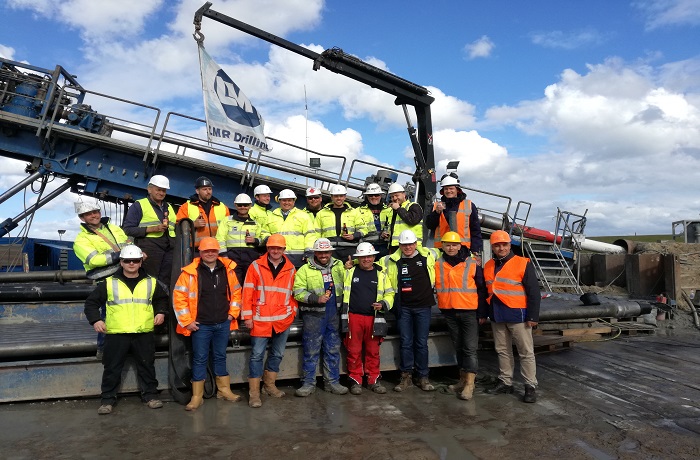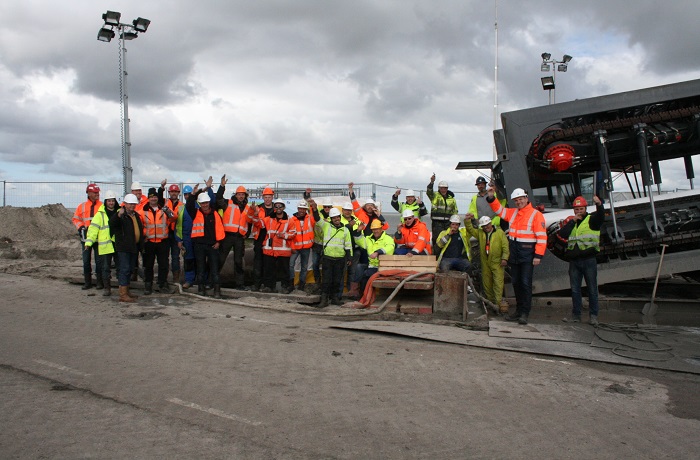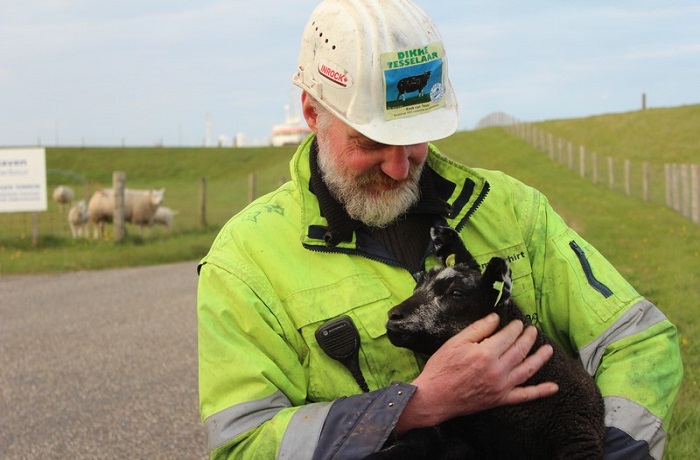Marsdiep crossing between Den Helder and Texel
The Marsdiep is a 4 km wide stretch of water between Den Helder and Texel Island, located in the north of the Netherlands. It is crossed by a busy shipping lane for commercial boat traffic and also provides access to the port of Den Helder which is the biggest port of the Dutch Navy. The water depth at Marsdiep is 32 m (LAT).

 24.05.2017
24.05.2017
In the 1980s PWN (Provinciaal Waterleidingbedrijf Noord-Holland), the local water supplier, used a shallow water pipe lay barge to install two HDPE water lines across the Marsdiep to provide Texel with a reliable supply of drinking water. Water supply worked well for many years. However, due to tidal currents the sea bed was heavily eroded, which eventually exposed both drinking water lines. Since that time preventive measures for temporary protection had to be taken by means of rock dumping, every year.
PWN realised that in several years the condition of the lines would deteriorate further and in 2011 commissioned feasibility studies to assess potential solutions. These focussed on different aspects by means of rehabilitation, replacement or reconstruction. One of those studies, focussing on HDD, was compiled by LMR. Amongst other things that study proposed doing first an extensive theoretical soil investigation research in data bases and archives which should be followed by a test drill campaign, all prior to signing a HDD contact.

In spring 2013 one of the two uncovered water lines failed completely and action had to be taken. The broken line was repaired and the above-mentioned data research for soil conditions took place. Following on from that a tender was launched for a test drill campaign. In compliance with these works test drills with lengths of 1.500 m and, optionally, 2.000 m and at different depths were proposed. Those test drills aimed to:
- identify an optimal geological layer through which to drill,
- provide data to determine:
- which drilling methods work well in relation to encountered soil conditions,
- reliability of mud systems,
- reliability of bore hole surveying systems,
- capability of HDD contractors,
- impact of a simulated break down scenario with 48 hrs stand still.
Those works were carried out in spring and summer 2015 by two different HDD contractors, one on Texel Island and the other one in Den Helder. LMR was in the lucky position to do these works in Den Helder. The works on the Texel site were executed by a competitor. The scope of these works and the experience gained have been described in some previously published papers. As such, we will dispense with repeating these findings here.
On completion of the test drills and an in-depth evaluation of the results, PWN compiled a tender for the installation of the new water supply pipeline to Texel. That tender requested turnkey solutions for either one or two crossings, depending on the pipe dimension to be chosen by the contractor. The tender included all related pipe and earth works and also the procurement of pipes.

The tender, of a restricted nature, was launched in winter 2016. All bidding parties had to submit with their tender an in-depth evaluation of known and possible risks, also showing the handling of those and their impact on time and costs. Those identified risks, their handling and the elimination of those risks, where possible, were major criterion for the bid evaluation. LMR did not enter this competition in an over-optimistic manner but nonetheless decided to make a detailed and compliant bid with their existing in-house capabilities. LMR provided a tender for a single drilled crossing for a DN 300 pipeline (rather than the alternative two crossings each for a DN 200 pipe) as they considered this viable and offering a much more cost-effective solution. After eight weeks of intensive bid preparation the bid was submitted and some weeks later LMR was invited to a bid meeting leading to an adjusted offer being resubmitted.
In June 2016 LMR learned with great pleasure that the contract would be awarded to LMR.
That order was followed by a rather long and extensive works preparation period. During that time, close collaboration took place with PWN and the partner companies PPS, Drillguide, HEADS, other suppliers and local authorities and the port administration of Den Helder.
In March 2017, the pipe works started with preparation of the 2.500 m long pipe welding site. That was followed by the delivery of the pipes and the related pipe works. In early April, the drill sites were prepared and the casing pipes for the start sections were installed. Upon completion of these works the drill spreads were mobilised to the sites and these were set up. On April 10th drilling operations started and on the late evening of April 18th the intersect operations could begin, which were finished early in the morning of April 19th. The intersection of both bore holes was followed by reaming operations, a check trip and then finally the pipe pulling operation. The pipe pulling operation lasted from April 27th to April 28th, as a golden joint had to be made.
In connection to the pipe pulling operation some post pull quality assurance works took place. These works showed no negative results, as such tie in could be made immediately afterwards. Today, the drinking water supply to Texel Island is once again secured for the coming decades.

Conclusion:
It is hard to summarize the nature of the works done by us in only a few lines. Reflecting the last weeks, we feel it is reasonable to state that this job site has run smoothly in our perception. The above lines may leave the impression that these works were from a technical point of view not demanding. We can assure in this respect that this is not the case. We are also glad to announce that 0 near miss incidents, 0 accidents and 0 environmental issues are to be reported.
Major keys to success were the open and honest dealing with the client and the partner companies as well as the extensive and far-sighted work preparation. Crossings of even greater distances will be feasible in future. The feasibility to implement such works will always depend on three aspects: soil conditions, the contractor and the contract agreed between the client and the contractor.
Finally, we would like to thank PWN and its supervision team on site (amongst others Episcope) for the confidence that was put in LMR, the Dutch Navy for hosting us and the cooperation on the navy yard, the project team around Thomas Winkler, Martin van der Waal and Bert Speelman, the drill crews as well as all partner companies, involved in the project execution (amongst others: PPS, de Romein, RKT, Drillguide, HEADS).
A video can be found in the Mediathek.
all news